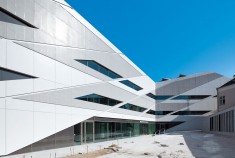
© Adam Mørk
Middelfart, a small town in the west part of the island of Funen, is in many respects typically Danish: plastered clinker houses and half-timbered buildings, rarely more than two storeys high, flank the Algade (designated as a pedestrian zone) situated in the heart of the town. The former industrial plants on the banks of the river have been replaced successively during the past ten years with river-bank promenades, a marina, residential buildings and a cultural centre. The new savings bank by architects 3XN is located between these two zones. It has an unobstructable north-facing sea view and, in the south, is part of the row of houses along Algade.
The incorporation of terraces under the large roof, which is open towards the sea, was the decisive factor that resulted in 3XN winning the competition. Here, it was possible to implement the credo of the architects, “to design buildings from the inside to the outside”, in an exemplary manner. “We had almost ideal conditions for such a space: the view towards the north with the sun at the rear. This is why we were able to glaze a large part of the roof, without having to fear problems caused by glare and overheating”, said Jan Ammundsen, a partner in 3XN and responsible for the competition design.
Although it is not a free-standing entity in the traditional sense, the new savings bank building does not have a proper rear side. It is possible to encircle the building and encounter a highly varied sequence of narrow alleyways and spacious forecourts as well as partly roofed-over pavements, pedestrian zones and several through-roads. The new building responds to each of these areas with a different use and a different degree of openness to the exterior. Only the west elevation of the building towers solidly over the adjacent car park like a typical feature of a big city. The other four facades are perfectly aligned to the eaves line of the surrounding buildings.
The north-aligned roof, with its 83 identical prefabricated dormers including glazing, is the real front of the new building to an even greater extend than the elevations. The roof surfaces generate views, allow daylight into the rooms and, at least partly, support the natural ventilation. The architects only had to give up their plan of being able to open the rhombic roof skylights above the hall: this would have made the seven metre long elements much less filigree and would have increased the costs to enormously. From a design point of view, this compromise paid off.
The main aim of the energy planners from COWI was to ventilate and cool the building naturally as far as possible. The bank obtains its heating energy from the local district heating network. Water pipes installed in the precast concrete ceiling elements provide heating and cooling. In Middelfart, this combination of prefabricated building and thermoactive components (TABS) was applied for the first time in Denmark.The concrete ceilings release their radiated energy both upwards and downwards.
The incorporation of terraces under the large roof, which is open towards the sea, was the decisive factor that resulted in 3XN winning the competition. Here, it was possible to implement the credo of the architects, “to design buildings from the inside to the outside”, in an exemplary manner. “We had almost ideal conditions for such a space: the view towards the north with the sun at the rear. This is why we were able to glaze a large part of the roof, without having to fear problems caused by glare and overheating”, said Jan Ammundsen, a partner in 3XN and responsible for the competition design.
Although it is not a free-standing entity in the traditional sense, the new savings bank building does not have a proper rear side. It is possible to encircle the building and encounter a highly varied sequence of narrow alleyways and spacious forecourts as well as partly roofed-over pavements, pedestrian zones and several through-roads. The new building responds to each of these areas with a different use and a different degree of openness to the exterior. Only the west elevation of the building towers solidly over the adjacent car park like a typical feature of a big city. The other four facades are perfectly aligned to the eaves line of the surrounding buildings.
The north-aligned roof, with its 83 identical prefabricated dormers including glazing, is the real front of the new building to an even greater extend than the elevations. The roof surfaces generate views, allow daylight into the rooms and, at least partly, support the natural ventilation. The architects only had to give up their plan of being able to open the rhombic roof skylights above the hall: this would have made the seven metre long elements much less filigree and would have increased the costs to enormously. From a design point of view, this compromise paid off.
The main aim of the energy planners from COWI was to ventilate and cool the building naturally as far as possible. The bank obtains its heating energy from the local district heating network. Water pipes installed in the precast concrete ceiling elements provide heating and cooling. In Middelfart, this combination of prefabricated building and thermoactive components (TABS) was applied for the first time in Denmark.The concrete ceilings release their radiated energy both upwards and downwards.












